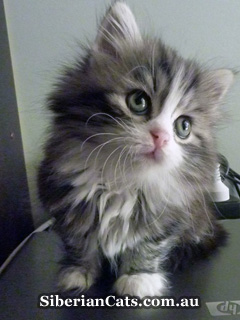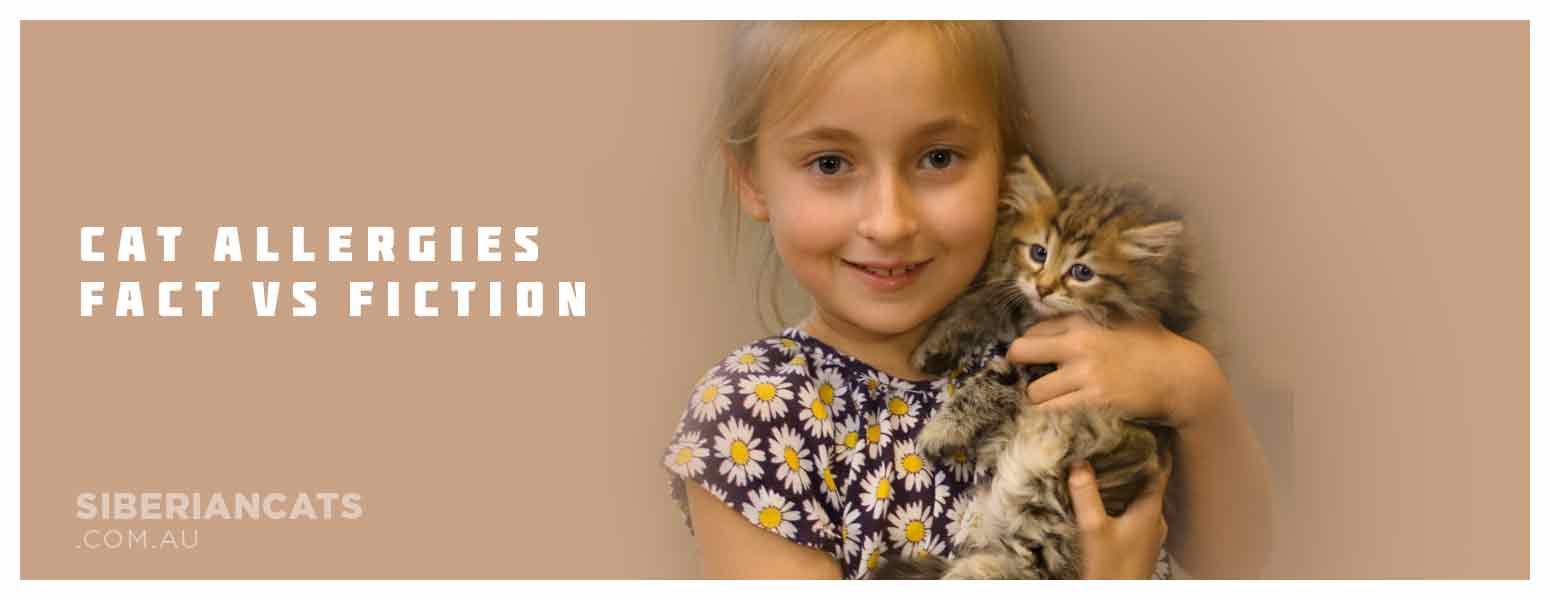Do You Suffer From Cat Allergies?
Have a cat allergy? After having had such a great success rate with new owners that are successfully living with a Siberian cat, this is due to the phenomenon of hypoallergenic cats. Want to learn about hypoallergenic cat breeds? Did you know it is actually not the fur thats the issue, but a protein in the saliva (Fel-Dh1) that the animal produces, which humans are allergic to. With hypoallergenic cats, there is very little to none of this particular protein produced.
It’s a dream for so many that thought cat ownership was impossible for them, that are very often able live with a Siberian cat!
I have put together some information that is available on many of the sites on the web and with permission have added it here for you to read. I do notice that I get a huge number of requests for female Siberian kittens as opposed to male Siberian kittens. Perhaps they are reading that the female is better than the male for dander and reactions, but to date I have not been able to ascertain that this is correct I have placed as many boys as girls into homes of people that have cat allergies and they do not seem to be any different to each other.
What Can You Do To Help With Cat Allergies?
What can People do to help minimize allergic reactions? Bathe the cat on a regular basis. Also before purchasing a new pet, if you yousuffer from pet allergies, you can request a “fur sample” from the breeder. This is a very common practice and can save you much hassle.
As Miakoschka Cattery is based in Queensland (near Brisbane) and my inquiries are coming from all over the Australia, I have several people that are also happy to help out with a visit so that you may also test how you react with their pets in their homes.
- Please contact me and I will see if I can put you in touch with your nearest Siberian owner…
- We don’t charge any fees for this service, as we feel that this is part of our commitment to try as best we can to help in your search to be able to own a cat.
- If we can not find an owner nearby we will will post you a sample of fur. Again this is free of charge 🙂
- But we do prefer you spend time with an owner and get a better reaction result.
We will not place a kitten or a cat into a home if you have allergies without prior testing.This ensures you will be okay and also that our kitten will not go through any undesired moves and stresses if our kitten/cat creates a reaction and can not remain in with your family in your home. Should you have severe allergies please ensure you bring any medication you take just in case it is needed. Remember we do not guarantee 100% that a Siberian will work for you. If you find that you have a failure with testing and you are still convinced that you would like to be a cat owner the only other option will be look at building up your immunity and this can be done with a specialist in allergies.
We do not intend to test our cats for any levels as the results from any testing that is currently being offered to date. Our research has led to the belief that what is on offer currently is too unreliable and not consistent enough to be a tool to be relied upon yet.
The Cause of the Cat Allergy
Proteins that are produced by the animal cause allergies. Cats produce a protein called Fel-Dh1. This is the protein that causes 85% of the allergies that people allergic to cats suffer from. The Siberian cat produces FAR less Fel-Dh1 then the average cat. The average cat produces 63,000 micrograms of Fel-Dh1, it is estimated that the female Siberian produces approximately 200 micrograms of Fel-Dh1 per gram.
Seventy to Ninety percent of the population that has cat allergies will most likely be able to live in a house with a Siberian cat…
The protein is given off when the cat licks or cleans itself and then the dried saliva flakes off, contrary to popular believe it is not the dander of the cat that is the allergy causer. With that said the Siberian also produces much less dander because they have an “oil” based skin. They are much less dry and their skin flakes much less.
There is also some great research done on families that have cats and asthma in the family. Studies show that families with pets, cats & dogs have children that have much less allergies to all things not only animal’s then families without pets. There are also studies that show a child with a pet is less likely to be sick and miss school then a child without one.
Cat Allergies – Fact and Fiction
Allergies may well trace back to the dawn of civilization but scientific comprehension of the immune system, what happens in an allergic reaction and what can be done about it, is very recent. So it’s not surprising that myths and misconceptions about pets and allergies exist. Some are factual to a degree, but others are totally incorrect and often influence our attitudes or knowledge about dealing with sensitivities to pets. Here are some of the most common myths…
There are “Non Allergenic” animals
![]() FALSE
FALSE
Any animal with fur or feathers can trigger an allergic reaction. These include cats, dogs, rabbits, guinea pigs, mice, horses, cattle, goats, pigs, chickens, and birds. Of these, research indicates that cats are by far the worst offenders, followed by dogs and horses.
While Siberian cats seem to be more tolerable than others, there are no dogs, cats or other furry animals that do not cause allergic responses. It makes no difference whether an animal has short hair, long hair or how much it sheds.
Shorthaired dogs and cats cause fewer allergy problems than those with long hair.
![]() FALSE
FALSE
All dogs and cats shorthaired, longhaired, wire haired, curly haired, even hairless can potentially trigger an allergic reaction. Allergic reactions to dogs and cats are not caused by the hair or fur but by dander (the tiny scales of dead skin) and by sebaceous and salivary gland secretions. Shorthaired dogs and cats cast off as many allergens into the environment as longhaired ones do.
Dogs and cats that do not shed hair are “hypoallergenic.”
![]() FALSE
FALSE
Whether a dog or a cat sheds hair or does not shed hair also makes no difference. Certain dog breeds Poodles, Bichon Frises, Bedlington Terriers and Kerry Blue Terriers as well as Cornish Rex, Devon Rex and Sphinx cats shed little or no hair. It is surprising how many pet owners have bought these breeds because they were told they did not cause allergies.
While it has recently been established that some animals cast off more allergens than others, there are no non-allergenic dogs or cats. The reason Poodles, Bichon Frises, Bedlington and Kerry blue terrier dogs are thought to be “safe” is probably because they are shampooed and groomed regularly and therefore cast off less dander in the home.
Some people may have more problems living with dog and cat breeds that shed hair profusely because of the excessive amount of loose hair contaminated by dried saliva and dander clinging to it shed from the pet onto the rugs, furniture and the pet’s bedding and favourite lounging places. Frequent vacuuming is usually necessary, along with the use of a moist sponge, to pick it up.
 Puppies and kittens cause fewer allergy problems than adult pets.
Puppies and kittens cause fewer allergy problems than adult pets.
![]() TRUE
TRUE
Baby animals have no old skin to shed and consequently have no dander. It usually takes a few months before kittens and puppies produce these allergens. This may explain why people who buy young pets become allergic to them when they reach maturity.
People can be allergic to some breeds of dogs and not to others.
(?) UNKNOWN
The possibility of dog breed-specific allergens was first investigated many years ago, reports Dr. David Knysak of the Department of Medicine’s Allergy Division of the University of Michigan Medical Center. Subsequent studies have determined both qualitative and quantitative variations in the antigen content extracts derived from different dog breeds, however, he adds, no breed-specific allergens have been found.
It is true, though, that an individual may occasionally become sensitised to or build up resistance to a single breed over a period of time. Another reason why people may think they are allergic to certain breeds of dogs and cats is that some animals shed many more allergens than others, a process which may produce a higher level of exposure and consequently more allergic symptoms.
Restricting a dog or a cat to one or two rooms of the house will make it easier to tolerate.
![]() FALSE
FALSE
The longer a pet lives in a home, the more its allergens will have permeated the entire house to cause symptoms. Isolating a pet to one or two rooms in the home does not contain their allergens. Air currents from forced-air heating, air conditioning and fans spread the allergens through the house.
Airborne cat allergens have been measured in several clinical studies and have been found to be infinitesimally tiny in size. The Fel d1 particles ranged in size from 1 micron to about 20 microns, with a significant percentage being about 2.5 microns in diameter. What size is a micron? As an example of just how small one is, the period at the end of this sentence is nearly 1,000 microns in diameter!
Such particles tend to remain airborne for hours, even in homes with minimal disturbance. Once they do settle, vacuuming or walking on the carpet, sitting on the furniture, fluffing up cushions pillows and the pet’s bedding, raising or lowering the blinds, and opening or closing the drapes or curtains causes tremendous amounts to be set loose in the air once again.
Pets that live outside cause fewer allergy problems.
![]() TRUE
TRUE
Pets that remain outdoors at all times cause very few allergy problems. But when an allergic person goes outside and plays with the animal, pets it, or holds it in his or her lap, symptoms can occur. Although many pets are never allowed into a house, bear in mind that those that do live outdoors are exposed to many risks. They may be lost or stolen, attacked by other animals, run over by cars, poisoned deliberately or inadvertently.
Rabbits and other small furry caged pets and birds are safe for allergy sufferers because they don’t have the run of the house.
![]() FALSE
FALSE
Rabbits, small furry animals (guinea pigs, ferrets, rats and mice) have become increasingly popular as house pets. They are small, clean, easy to care for, inexpensive to feed, they don’t bark to annoy neighbours and they are permitted in many apartment complexes where cats and dogs are prohibited. The urine, saliva and dander of small furry pets are potent allergens and contribute significantly to the allergen source in the home. The number of allergens they spread depends on their species, their size and number and how frequently family members handle them.
Birds are also growing in popularity as pets. Their major allergen is derived from feather dust, which is also called “powder.” When birds preen themselves and flutter their wings, no matter how small they may be, they shake feather dust into the air where it collects in and around the cage and also circulates throughout the house. Some of the larger species of parrots may cause more allergy problems since they can produce enough powder to coat most surfaces in the room in which they are caged on an almost daily basis.
People can be more allergic to their pets in the spring and the fall.
![]() TRUE
TRUE
Cat and dog allergens, feathers, house dust, and moulds are just a few of the culprits that cause the symptoms of perennial, or year-round allergic rhinitis. In most parts of the country, tree and grass pollen or mould spores in the spring, other weeds pollen in autumn, are triggers of hay fever or seasonal allergic rhinitis. People who are sensitive to pets and to trees, grasses and weeds usually find their symptoms are much worse during pollen seasons because of an overlapping of seasonal and perennial allergens.
People can tell if they will be allergic the first time they encounter a pet.
![]() FALSE
FALSE
No one is allergic to a substance the first time he or she comes in contact with it. Sensitisation, or the process that leads to development of symptoms, requires repeated exposures over a period of time, anywhere from days to months and possibly years. Sometimes, though, only a few minutes of a pet’s presence is necessary. People who come in contact with a cat, for instance, or who enter a room where a cat has been, may react to it within seconds. Other times an animal can be kept for many years and then suddenly its owner will become severely sensitive to it.
People can be allergic to clothing made from animal fur.
![]() TRUE
TRUE
It is possible for potentially allergic people to be sensitive to the animal fur and wool found in clothing, cushions, fabrics, blankets, sweaters, the linings of gloves, rugs, toys, furniture stuffing, and a myriad of other household items. Items made from rabbit fur, for example, can be a real source of sensitivities because the fur is too delicate to remove all traces of dander and dried saliva.
Dr. Ralph Bookman, allergist to former President Ronald Reagan noted in an interview published in Rodale’s Allergy Relief Newsletter:
…that if someone owns “a true Oriental rug — one actually made in the Orient — then it is certainly loaded with sheep, goat and camel dander.” Good quality domestic wool, added Dr. Bookman “is processed to be dander-free” it is not allergenic. However, it is irritating to many people, and not just those with allergies. Wool from third-world countries is not treated after it’s taken from the animal. This kind of wool can contain a lot of dander and cause serious allergy problems.”
Recent News – Results for testing of Fel d1 in fur samples
These tests were performed in Dec 1999, by an independent lab in Virginia – Indoor Biotechnologies, 1216 Harris St, Charlottesville, VA 22903. The results are as follows:
- (male, neutered, mixed breed) 62,813
- (male, neutered, Siberian) 2001
- (female ,Abyssinian, neutered) 384.50
- (female, neutered, Siberian) 205.50
- Measurements are mg/g of sample
This would indicate that the Siberian and Abyssinian have considerably less than the standard house cat, and that females, have less Fel d1 than the males.
Terminology
FEL D1 Cats – The types of cats cause more severe allergic reactions than other pets. The major cat allergen is an extremely potent one called Fel d1. Secretions from the sebaceous glands of the skin are the primary source of Fel d1, but it is also deposited on the fur through the saliva when cats clean themselves through the licking or self-cleaning process. Eventually the Fel d1 flakes off and becomes airborne to trigger the symptoms that characterize allergies to cats. Male cats generally produce more allergens than females do.
Dander – The problem is not with the pet’s hair. It is the dander, or microscopic scales of dead skin (similar to, but much smaller than the dandruff on the human scalp) which pets are constantly shedding that is the cause. They are so tiny that you seldom, if ever, know that they are circulating in the air or laying on the furniture and carpets.
Urine – Recent studies indicate that urine (protein), from cats and dogs as well as from ferrets, guinea pigs, hamsters, and mice, contain allergens, which can also trigger allergic reactions.
- More about the breed visit our Siberian Cat FAQ Page
- For pictures/info about our newest litters Siberian Kittens


